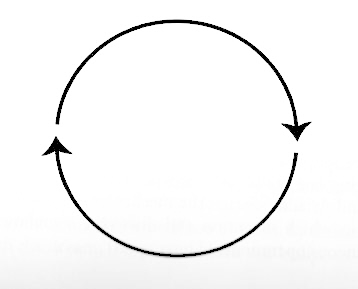
Audio feedback loops are a well-known standby of rock and roll groups; if you plug a microphone into a speaker set, and allow the mic to pick up the audio from the speaker it is connected to, a feedback loop is created that results in high pitched squealing. This is because the sound from the speaker is recorded by the microphone, and replayed and reinforced over and over again. It’s harmful to the hardware and your ears alike, so I don’t recommend you trying it, but at the very least, it’s interesting for audiophiles to study, so that they can prevent it from happening.
Video feedback loops are more rarely seen in conversation and in life, although they are not as tricky to produce. An example of a video feedback loop is setting up two mirrors facing one another, such that you create an infinite nesting of the images in either mirror. You can do the same thing with two video capture cameras connected to two screens – just line them up facing each other, and you will be rewarded with an ever shrinking loop of repeated images. Another way to do it that I don’t know about from personal experience, per se, is a makeup compact mirror reflecting off a persons eye as they pluck eyebrows or apply mascara or whatnot. Some variations of this visual feedback phenomena are difficult to see, like a trombone’s slide, reflecting on the player’s right hand sheath – all the brilliance of reflection is left on the inside.
The power of the universe to convey these sensations visually through a medium is infinite, limited only by the observer’s acuity of perception. We would definitely reach that point before we reached the point of inability of the physical universe to convey the repetition. Infinity is used to describe things that are as large as large can get. Even infinities that approach zero size in their sequences of growth are hard to comprehend by the human mind. The mind is taxed when focusing on the reduplicated images, and it can be difficult to count each layer of repetition without getting lost in the microcosm. However, with mathematical simile, we often find that these repetitions can be reduced into a simple algorithm describing the scale of shrinkage or growth with each repetition as a pattern approaches the limits of the universe (i.e. the tool; better tools can produce better patterns faithfully) to continue with the generation of the image or sound.
I think some manmade [capture and production] technologies might cull the degree of feedback [visually or aurally] provided to the observer, in order to save on [processing and work], in effect, limiting the number of reflections and repetitions in a given feedback loop. For example, if you were simulating the reflections on two facing mirrors in a 3D computer video engine, the engine might stop processing the reflections once they had reached the size of a single pixel on the monitor, in order to prevent what is called a “memory leak”. A memory leak is when a system is overworked by some element (usually a recursive element) and causes an overwhelmingly large draw of resources that can cause unresponsiveness in the system, due to it’s inability to complete the task at hand.
Having all of that to think about, here’s a jaunty song with wholly appropriate video accompaniment:

Leave a Reply
You must be logged in to post a comment.